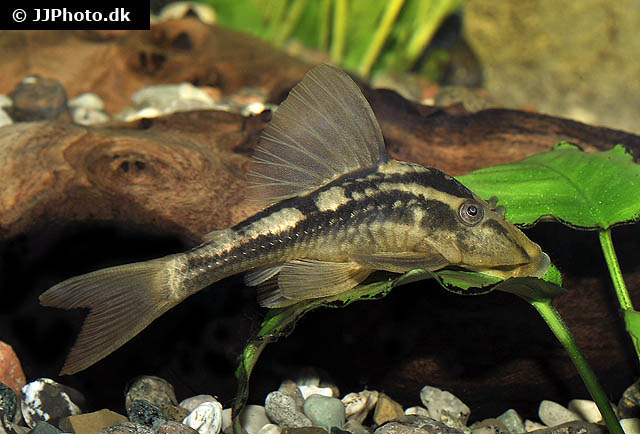| Loricariidae (Armored catfishes), subfamily: Hypostominae |
| 19.78 cm SL (male/unsexed) |
|
demersal; freshwater, |
| South America: Rio Salobra basin of the rio Paraguay basin, Bodoquena Plateau in Mato Grosso do Sul, Brazil. |
|
Dorsal spines (total): 2-2; Dorsal soft rays (total): 7-7; Anal soft rays: 5-5. Hypostomus basilisko is distinguished from all congeners, except those belonging to the H. cochliodon group, by having the following unique combination of characters: absence of notch between metapterygoid and hyomandibula(vs. presence of notch); and strongly angled dentaries, less than 80° (vs. shallow angle between dentaries, generally more
than 80°). It differs the other members of H. cochliodon group, except H. pagei and H. soniae, by the absence of spots on body and fins (vs. presence of spots). It is distinguished from H. pagei by having highly developed keels on lateral series of plates (vs. keels weak, almost absent); from H. soniae for having teeth with a large spoon-shaped mesial cusp and a lateral cusp, if present, almost imperceptible (vs. teeth with mesial cusp conspicuously enlarged and rounded but not spoon shaped; distinct lateral cusp) and massive odontodes covering the dorsal region of head and trunk, forming well-developed keels (vs. less developed odontodes on head and trunk, keels absent or
weakly-developed). It can be distinguished from H. soniae by the possession of many well-developed papilla on the internal surface of anterior and posterior jaws (vs. few papillae on the internal surface of anterior and posterior jaws); from H. cochliodon and H. khimaeraby having 27 vertebrae (29 and 28, respectively); from H. hondae (Regan) and H. plecostomoides (Eigenmann) by the absence of platelets in the skin around dorsal-fin base (vs. presence); from H. levis by the presence of an adipose fin (vs. absence); from H. taphorni by having both caudal-fin lobes evenly colored (vs. bicolored caudal fin with ventral lobe darker) (Ref. 97225). |
| Occurs in clear-water streams and rivers. Larger fish remain during the day lying on soft-bottom patches (mainly on sand, sometimes on leaf litter) at deeper sites and forage mainly during the night at shallower areas with rocky bottom. Grazing during the day were occasionally observed. Small fish forage during the day and night, always in shallower areas. Individuals feed mainly on periphyton from rocky substrates, but also explore from submerged logs and branches (Ref. 97225). |
|
Not Evaluated (N.E.) Ref. (130435)
|
| harmless |
|
Source and more info: www.fishbase.org. For personal, classroom, and other internal use only. Not for publication.

